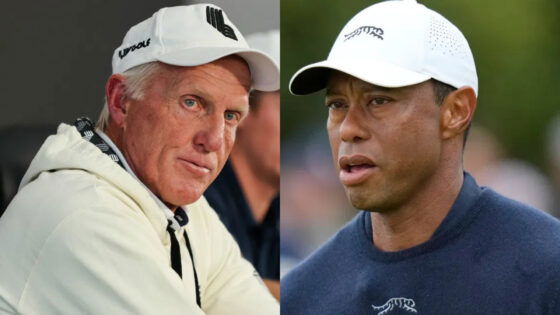“Great White Shark.” That was Greg Norman’s nickname during his prime. He was bold, aggressive, and tough to beat. With 20 PGA Tour wins and two major championships, Norman built a strong global career. He held the world No. 1 ranking for 331 weeks, more than anyone else at the time. But the most fascinating and heartbreaking aspect of Norman’s legacy is how often he came agonizingly close to major championship glory.
Despite his immense talent and repeated contention, he walked away with just two majors, while several others slipped through his fingers in dramatic, often avoidable ways. It’s a topic that often comes up, and recently, a few golf insiders revisited Greg Norman’s career.
“Greg is in that category of the what-ifs, what could have been. You can focus on 1986 exclusively in terms of the Saturday Slam and what could have been, and some of it you can say was self-inflicted,” said a golf insider on the 5 Clubs Podcast, looking back at one of the most talked-about years in Norman’s career. In 1986, Norman had the 54-hole lead in all four majors, which is pretty rare, but he only came out on top once.
A look at Norman’s Saturday Slam:
Masters: Jack Nicklaus took charge of the back nine on Sunday. After losing his lead early in the round, Norman tried hard, tying Nicklaus by the time he reached the 18th hole. Then, the Aussie bogeyed the hole from the middle of the fairway.
PGA Championship: Kevin Tway holed a shot from the bunker, but Norman shot a 76 on the final round to lose by two strokes. and settling for a runner-up spot.
US Open: Norman shot a 75 in the last 18 holes, going from the lead to a tie for 12th.
British Open: He won by five shots, earning his first major.
While Greg was constantly in the mix, he couldn’t finish the job when it mattered most. Unlike Tiger Woods. Woods completed the career Grand Slam in 2000 by winning The Open Championship at St. Andrews, becoming the youngest to do so since Jack Nicklaus. That same year, he went on a historic tear, winning the U.S. Open, The Open, and the PGA Championship back-to-back, all by dominating the field and never letting go of a lead once he had it. It’s not like Norman did not have the opportunities; how he missed those is a topic of concern here.
“14 times he had on Sunday a share of the lead or better in a major championship, and he won only two of them… Let’s say he wins half of those 14… He would have been close to the top 15,” the hosts shared. For all the talk and all the talent, 1986 became the year Norman was everywhere except in the winner’s circle when it counted most. Looking back, if he had managed to win even half of the 14 majors where he was in position on Sunday, his name would likely sit among the top 15 players of all time. But all of it was not just bad luck; he indeed has made some costly mistakes.
“Greg Norman, he’s a victim of fate, and to some degree it’s true, but he also made the wrong decisions at the wrong time, and that really cost him a lot,” shared the hosts. He’d take on risky shots when a safer play would’ve done the job. He didn’t always manage the pressure well. The 1996 Masters is the best example.
He had a six-shot lead going into Sunday but kept playing aggressively instead of protecting what he had. One mistake led to another, and Nick Faldo walked away with the win. Greg Norman’s career may be remembered for missed chances, but his name still echoes across the sport, and that says something. In a game that rarely forgets failure, Norman’s name still holds significant weight in golf.
Greg Norman’s second act
Over time, Norman quietly shifted away from full-time competitive play. His last major spotlight as a player came at the 2009 Open Championship, where he briefly contended at age 54, but even as his appearances on the course became rare, Norman’s involvement in the sport never stopped. He simply moved from the fairways to the boardrooms, focusing his energy on building the game rather than playing it.
He had already founded Greg Norman Golf Course Design back in 1987, and after stepping away from the tour grind, he turned it into one of the most successful design firms globally, with over 120 courses across 30+ countries.
In 2021, Greg Norman stepped back into the spotlight as the founding CEO of LIV Golf, leading a bold push to shake up the traditional golf world. He helped launch the league, brought in big names, and stirred plenty of debate along the way. In 2025, he stepped down as CEO but didn’t step away; he stayed on the board and still plays a role in shaping LIV’s direction. And since then, he’s stayed busy.
Norman is leading a major revamp of North Adelaide Golf Course, a site being prepped for future LIV events. He’s also joined the organizing committee for the 2032 Brisbane Olympics, helping shape how golf will be staged on one of the sport’s biggest stages.
And by now, it’s crystal clear that Norman may not compete anymore, but golf remains a massive part of his life and legacy.
The post Greg Norman Would be in Same League as Tiger Woods but ‘Wrong Decisions’ Cost Him, Asserts Analyst appeared first on EssentiallySports.
